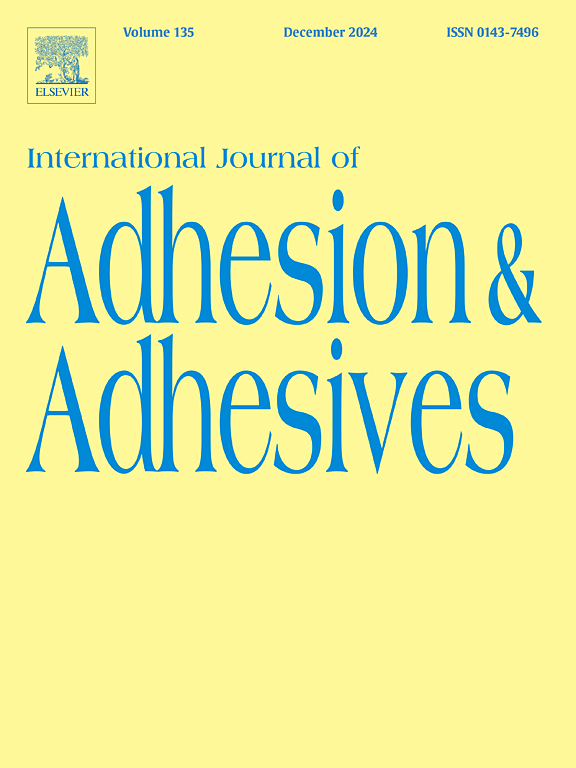Investigation of the differences in the lap-shear strengths of sulphuric acid anodised aluminium alloy AA6060-T6 joints bonded with hot and cold cure adhesives
IF 3.5
3区 材料科学
Q2 ENGINEERING, CHEMICAL
International Journal of Adhesion and Adhesives
Pub Date : 2025-10-08
DOI:10.1016/j.ijadhadh.2025.104173
引用次数: 0
Abstract
The automotive industry is becoming increasingly reliant on adhesives for joining components, due to their versatile applications and high-performing mechanical properties. Conventional adhesives are one-part, epoxy-based systems that require a high-temperature cure (180°C–200 °C), resulting in a substantial energy consumption and restricting the variety of materials that can be bonded. These drawbacks can be eliminated through adopting cold-cure adhesives ( 20 °C), however these adhesives lack the high-performing mechanical properties of their hot-cure counterparts. Addressing this, the differences in structure and chemistry between hot and cold curing adhesives were investigated, focusing on bonding anodised aluminium joints. The structure of the bonding interface was analysed using Scanning Electron Microscopy (SEM), whereas the chemistry involved was determined through Fourier Transform InfraRed (FT-IR) and X-ray Photoelectron Spectroscopy (XPS). Lap-shear results showed that significant adhesion was achieved between the aluminium oxide coating and the hot- and cold-cure adhesives. The cold-cure adhesive was found to contain 10.6 % fewer hydroxyl groups at the bonding interface. Functional bonding groups corresponding to aluminium silicate bonds were detected at interface of anodised aluminium joints bonded with cold cure adhesives, but these bonds were absent at interface of joints bonded with the hot cure adhesive. Although differences in functional bond groups were found to exist at the interface between the anodised aluminium and cold or hot cure adhesives, all tested lap-shear joints exhibited cohesive failure regardless of the adhesive being hot or cold curing. Results from this investigation indicates that the lower lap-shear performance of anodised joints bonded with the cold cure adhesive compared to those bonded with the hot cure adhesive stems from differences in the bulk properties of the adhesives themselves, suggesting that the cold cure adhesives have inferior mechanical bulk properties compared to the hot cure adhesive.
硫酸阳极氧化铝合金AA6060-T6接头冷热固化粘结剂的搭接剪切强度差异研究
由于粘合剂的多用途应用和高性能的机械性能,汽车工业越来越依赖于粘合剂来连接部件。传统的粘合剂是单组分环氧基系统,需要高温固化(180°C - 200°C),导致大量的能源消耗,并且限制了可以粘合的材料的种类。这些缺点可以通过采用冷固化胶粘剂(~ 20°C)来消除,但是这些胶粘剂缺乏热固化胶粘剂的高性能机械性能。针对这一问题,研究了热固化和冷固化胶粘剂在结构和化学上的差异,重点研究了阳极氧化铝接头的粘合。利用扫描电子显微镜(SEM)分析了键合界面的结构,通过傅里叶变换红外(FT-IR)和x射线光电子能谱(XPS)确定了所涉及的化学成分。搭剪结果表明,氧化铝涂层与冷热固化胶粘剂之间具有明显的粘结性。发现冷固化胶粘剂在键合界面上含有的羟基减少了10.6%。冷固化粘结剂在阳极氧化铝接头界面上检测到与硅酸铝键对应的官能团,而热固化粘结剂在阳极氧化铝接头界面上不存在这些官能团。虽然在阳极氧化铝和冷固化或热固化胶粘剂之间的界面上发现功能键组存在差异,但所有测试的搭剪接头都表现出粘结破坏,无论胶粘剂是热固化还是冷固化。研究结果表明,冷固化胶粘剂与热固化胶粘剂粘结的阳极氧化接头的搭剪性能较低,这是由于胶粘剂本身的体积性能不同,表明冷固化胶粘剂的机械体积性能不如热固化胶粘剂。
本文章由计算机程序翻译,如有差异,请以英文原文为准。
求助全文
约1分钟内获得全文
求助全文
来源期刊

International Journal of Adhesion and Adhesives
工程技术-材料科学:综合
CiteScore
6.90
自引率
8.80%
发文量
200
审稿时长
8.3 months
期刊介绍:
The International Journal of Adhesion and Adhesives draws together the many aspects of the science and technology of adhesive materials, from fundamental research and development work to industrial applications. Subject areas covered include: interfacial interactions, surface chemistry, methods of testing, accumulation of test data on physical and mechanical properties, environmental effects, new adhesive materials, sealants, design of bonded joints, and manufacturing technology.
 求助内容:
求助内容: 应助结果提醒方式:
应助结果提醒方式:


